

Molting: How Crabs Grow
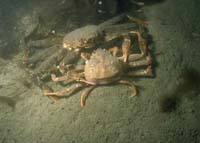
Crabs (and other crustaceans) cannot grow in a linear fashion like most animals. Because they have a hard
outer shell (the exoskeleton) that does not grow, they must shed their shells, a process called molting. Just
as we outgrow our clothing, crabs outgrow their shells. Prior to molting, a crab reabsorbs some of the
calcium carbonate from the old exoskeleton, then secretes enzymes to separate the old shell from the
underlying skin (or epidermis). Then, the epidermis secretes a new, soft, paper-like shell beneath the
old one. This process can take several weeks.
A day before molting, the crab starts to absorb seawater, and begins to swell up like a balloon. This helps
to expand the old shell and causes it to come apart at a special seam that runs around the body. The
carapace then opens up like a lid. The crab extracts itself from its old shell by pushing and compressing
all of its appendages repeatedly. First it backs out, then pulls out its hind legs, then its front legs,
and finally comes completely out of the old shell. This process takes about 15 minutes.
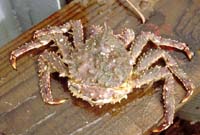 Over the next few weeks, the crab gradually retracts all of its body parts from the outer shell by a few
millimeters, while it begins to secrete a new shell beneath the old one. If we pull off one of the small
mouthparts from the crab, and place it under a microscope, you can see the new shell beginning to retract
from the old one. When a crab molts, it removes all its legs, its eyestalks, its antennae, all its
mouthparts, and its gills. It leaves behind the old shell, the esophagus, its entire stomach lining, and
even the last half inch of its intestine. Quite often, many crabs in a population molt at the same time of
year, and their old shells wash up on the beach. If you find something on the beach that looks like
a dead crab, pick it up, open the lid, and look closely inside. If nobody is home, it is a cast-off
exoskeleton.
Over the next few weeks, the crab gradually retracts all of its body parts from the outer shell by a few
millimeters, while it begins to secrete a new shell beneath the old one. If we pull off one of the small
mouthparts from the crab, and place it under a microscope, you can see the new shell beginning to retract
from the old one. When a crab molts, it removes all its legs, its eyestalks, its antennae, all its
mouthparts, and its gills. It leaves behind the old shell, the esophagus, its entire stomach lining, and
even the last half inch of its intestine. Quite often, many crabs in a population molt at the same time of
year, and their old shells wash up on the beach. If you find something on the beach that looks like
a dead crab, pick it up, open the lid, and look closely inside. If nobody is home, it is a cast-off
exoskeleton.
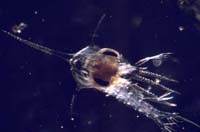 A king crab may molt 20 times in its life. After hatching out as a planktonic larva, it molts 4 times, at
1-2 week intervals, before becoming a small crab. In its first year of life, it may molt 6 more times. The time
between molting (the inter-molt period) gets longer with every molt. A 2-year old crab may molt only 3 times,
a 3-year old only twice. By the time they are 4 years old, king crabs will molt only once per year. They
become sexually mature at about 5 years of age. After that, the females must molt every year in order to mate,
but the males molt less and less often. Very old males may not molt for 3 years or more.
A king crab may molt 20 times in its life. After hatching out as a planktonic larva, it molts 4 times, at
1-2 week intervals, before becoming a small crab. In its first year of life, it may molt 6 more times. The time
between molting (the inter-molt period) gets longer with every molt. A 2-year old crab may molt only 3 times,
a 3-year old only twice. By the time they are 4 years old, king crabs will molt only once per year. They
become sexually mature at about 5 years of age. After that, the females must molt every year in order to mate,
but the males molt less and less often. Very old males may not molt for 3 years or more.
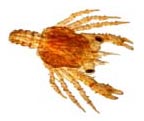 After molting, the crab is full of water, so they are not very good to eat. Growth of the crabs body occurs
during the intermolt period, as the water is replaced by protein. The new shell is very soft at first, making
the crab vulnerable to predators. Within a few days, the shell hardens up, and it becomes very hard after a month.Besides allowing the crab to grow, molting helps to get rid of parasites, barnacles, and other animals growing
on the shell. It also helps to get rid of shells damaged by bacteria that degrade the chitin in the exoskeleton.
After molting, the crab is full of water, so they are not very good to eat. Growth of the crabs body occurs
during the intermolt period, as the water is replaced by protein. The new shell is very soft at first, making
the crab vulnerable to predators. Within a few days, the shell hardens up, and it becomes very hard after a month.Besides allowing the crab to grow, molting helps to get rid of parasites, barnacles, and other animals growing
on the shell. It also helps to get rid of shells damaged by bacteria that degrade the chitin in the exoskeleton.
Crabs that have lost legs can regenerate them over time. The leg breaks off at a special joint. Before molting,
a new limb bud, with all the remaining leg segments, grows out of the joint. After molting, the new leg is
smaller than the others. The crab needs three molts to grow a leg back to its normal size. Old crabs, or
those that are not molting regularly, may never grow their legs back to full size.
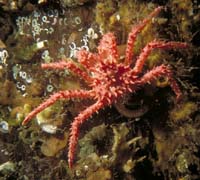 To say this is an amazing process is a major understatement, and it has been the focus of research by many
scientists for decades. Molting takes place about 15-20 times in the life of a crab. A king crab may molt six
times in its first year, four in its second, two or three times in it’s third, and after that, perhaps only
once a year. After sexual maturity, the females continue to molt annually, while intermolt periods become
continuously longer for the males, so that they only molt once every few years or so.
To say this is an amazing process is a major understatement, and it has been the focus of research by many
scientists for decades. Molting takes place about 15-20 times in the life of a crab. A king crab may molt six
times in its first year, four in its second, two or three times in it’s third, and after that, perhaps only
once a year. After sexual maturity, the females continue to molt annually, while intermolt periods become
continuously longer for the males, so that they only molt once every few years or so.
written by Dr. Bradley G. Stevens, formerly of AFSC Kodiak Laboratory
|